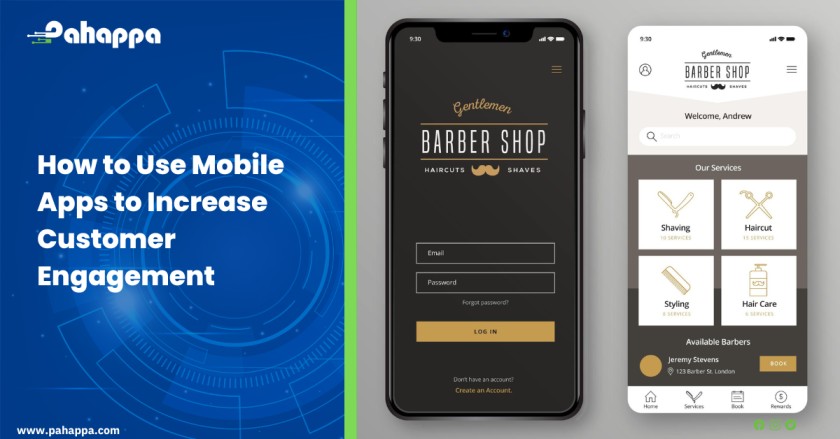In today’s fast-paced digital landscape, businesses face a constant challenge: capturing and retaining the attention of their target audience. With smartphones becoming ubiquitous and people spending a significant portion of their time on mobile devices, the power of mobile apps as a tool for customer engagement cannot be ignored. Mobile apps offer a unique opportunity to create personalized, interactive, and immersive experiences that resonate with users on a deeper level. In this article, we delve into the world of mobile apps and unveil features and actionable strategies to increase customer engagement.
How Mobile Apps Help to Increase Customer Engagement
- Accessibility and Convenience
Mobile apps provide a convenient and readily accessible platform for customers to interact with a business. With a simple tap on their smartphone screens, customers can access the app anytime and anywhere, enabling seamless engagement with the brand’s products, services, or content. The ease of use and accessibility of mobile apps encourage regular and frequent interactions, boosting customer engagement.
- Personalization
Mobile apps enable businesses to gather user data and preferences, allowing them to deliver personalized experiences. By tailoring content, recommendations, and offers based on individual customer preferences, mobile apps create a sense of relevance and exclusivity. Personalization fosters a deeper connection with customers, increases engagement levels, and encourages repeat visits and purchases.
- Enhanced User Experience
Mobile apps offer a platform for businesses to provide a rich, intuitive, and user-friendly experience. The user interface can be designed specifically for mobile devices, ensuring a seamless and optimized experience. Mobile apps often provide faster loading times, smoother navigation, and greater interactivity compared to mobile websites, resulting in a more engaging and enjoyable user experience.
- Push Notifications and Alerts
Push notifications are a powerful tool for engaging customers and driving them back to the app. Businesses can send targeted and timely notifications to app users, informing them about exclusive offers, new product releases, personalized recommendations, or upcoming events. By leveraging push notifications effectively, businesses can capture users’ attention and prompt them to engage with the app, increasing customer engagement and conversions.
- Loyalty Programs and Rewards
Mobile apps provide a platform for implementing loyalty programs and rewards, which can significantly boost customer engagement and retention. By offering exclusive discounts, rewards, or points accumulation systems within the app, businesses incentivize customers to actively engage with the brand. These programs foster a sense of loyalty, encourage repeat purchases, and drive ongoing customer engagement.
- In-App Communication Channels
Mobile apps can incorporate in-app messaging, live chat, or customer support features, allowing direct communication between businesses and customers. This facilitates quick and personalized responses to customer inquiries, feedback, or support requests. Seamless communication channels within the app enhance customer satisfaction, build trust, and increase engagement by providing a convenient and immediate way to address customer needs.
- Gamification and Interactive Elements
By incorporating gamification elements such as challenges, quizzes, leaderboards, or progress tracking, mobile apps create interactive and engaging experiences. Gamification techniques tap into users’ natural inclination for competition, achievement, and enjoyment, encouraging them to actively participate, explore various features, and spend more time within the app. This heightened engagement can lead to increased brand loyalty and advocacy
Strategies to Increase Customer Engagement using mobile apps
- Simplify Onboarding
A streamlined onboarding process is crucial to provide a positive first impression. Make the signup or login process quick and hassle-free, by utilizing social login options or simplified form fields. Provide clear instructions or interactive tutorials to help new users understand the app’s features and benefits. By reducing friction during onboarding, you create a user-friendly experience that encourages users to engage with the app.
- Personalize Content
Leverage user data and preferences to offer personalized content within the app. Analyze user behavior, purchase history, or demographic information to deliver tailored recommendations, product suggestions, or content based on individual interests. This level of personalization enhances relevance, making users more likely to engage with the app as they receive content that matches their preferences.
- Gamify the Experience
Integrating gamification elements adds a layer of interactivity and enjoyment to the app experience. Incorporate challenges, quizzes, or leaderboards to encourage users to complete specific actions or compete with others. Reward users with badges, virtual currency, or unlockable content to create a sense of achievement and progress. Gamification increases engagement by tapping into users’ natural desire for competition, rewards, and a sense of accomplishment.
- Implement Push Notifications Strategically
Push notifications are powerful tools to re-engage users and drive them back to the app. Craft targeted and timely notifications that provide value to users. For example, send personalized offers, time-sensitive promotions, or reminders related to abandoned carts. Ensure the notifications are well-timed, relevant, and not excessive, as users may be discouraged by too many notifications. Segment your user base based on preferences or behaviors to send more personalized and effective notifications.
- Offer Exclusive In-App Content or Rewards
Create a sense of exclusivity and reward for app users by offering exclusive content, discounts, or rewards that are only accessible through the app. This can include special promotions, early access to new products, or loyalty program benefits. By providing exclusive benefits, you incentivize users to engage with the app regularly to access these unique offerings, fostering ongoing engagement and loyalty.
- Enable Social Sharing
Integrate social media sharing features within the app, allowing users to share their app-related experiences, achievements, or content on their social networks. This can include sharing progress, high scores, completed challenges, or app-related content. By enabling social sharing, you tap into users’ social connections and extend the reach of your app, potentially attracting new users and increasing engagement through social interactions and user-generated content.
- Gather and Act on User Feedback
Provide channels for users to provide feedback, suggestions, or report issues within the app. Actively listen to user feedback and make improvements based on their suggestions. Regularly monitor user feedback to identify pain points or areas for enhancement. By actively addressing user feedback and making improvements accordingly, you demonstrate that you value their input, leading to increased engagement and satisfaction.
- Continuously Improve User Experience
Regularly update and enhance the app based on user feedback, analytics, and industry trends. Incorporate new features, fix bugs, optimize performance, and improve the overall user experience. Pay attention to user behavior data, such as user flow, drop-off points, or engagement metrics, to identify areas for improvement. By providing a consistently improved user experience, you keep users engaged and encourage them to continue using the app.
- Encourage User-Generated Content
Foster a community within the app where users can share their experiences, reviews, or content related to your brand. Encourage and incentivize user-generated content, such as testimonials, photos, or reviews, by offering rewards, featuring their content, or hosting contests. User-generated content fosters engagement by creating a sense of belonging and encouraging users to actively participate in the app community.
- Provide Seamless Customer Support
Offer in-app customer support features such as live chat, in-app messaging, or a knowledge base. Enable users to easily reach out for assistance, ask questions, or report issues within the app. Provide prompt and helpful responses to address user needs and resolve any problems they may encounter. Seamless customer support enhances the overall user experience, builds trust, and contributes to increased engagement by ensuring users feel supported and valued.
The power of mobile apps in driving customer engagement cannot be overstated. With the ever-increasing reliance on smartphones and the need for businesses to stand out in a competitive digital landscape, mobile apps provide a unique avenue to captivate and retain the attention of target audiences. Contact us today for professional mobile app services and get a free quote for your project











